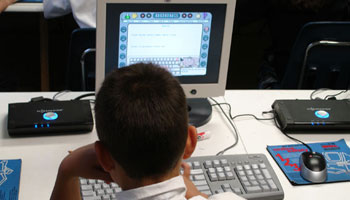£35 "PC" aims to bridge digital divide
NComputing device brings low-cost computing to developing world and education, with 300,000 already in use.


A 35 PC may sound an unattainable goal for squeezing shut the digital divide for the developing world and education, but NComputing have now brought theirs to the UK.
Similar to a thin-client setup, the 35 devices allow seven to 10 users to be connected to one standard 250 PC, while a computer worth twice that can handle 30 users, said Stephen Dukker, NComputing's chief executive and the former chief executive of eMachines.
"Now, even low end computers are supercomputers," he told IT PRO. "Much of that power is being wasted by having only one user."
Given the low price, the developing world and emerging markets make up 60 per cent of the 300,000 global deployments so far, with 100,000 seats sold in the US in education environments alone. "It's really quite amazing for a company no one's ever heard of," said Dukker.
For the X series of the system, a PCI card is plugged into the appropriate slot on a standard PC. Each card has three ports which link to a terminal which is in turn connected to a monitor, keyboard and other peripherals. To add more seats, simply add more PCI cards.
Teachers can also use the system to monitor what students are doing on their terminals, and if unhappy with what they see, they can send messages to students and take over the computing environment.
The ability to do this has been driven by the increasing power of basic PCs. "In the computing world, we've been able to deliver much more powerful computers, but not cheaper ones," said Dukker.
Sign up today and you will receive a free copy of our Future Focus 2025 report - the leading guidance on AI, cybersecurity and other IT challenges as per 700+ senior executives
The 35 device costs just 6 to manufacture, allowing savings to be passed onto schools and customers to spend more money on support and applications.
Like thin-client setups, the devices offer environmental benefits. "A traditional PC consumes 200 to 300 watts. These consume five watts," said Dukker. "They pay for themselves in five months alone in energy cost savings."
According to analysts IDC, some 940,000 PCs were sold to US schools in the first quarter of this year. With some 22,000 seats of NComputing's product selling in the same time frame, the device has some 2.5 per cent of that market already. "It's a pretty remarkable thing and shows how US education has embraced this technology," he said.
He said that after two school districts in the state of North Carolina deployed the system, 17 others followed suit, buying 10,000 seats. "It was so shocking. The state invited us to a conference to let everyone else know," said Dukker.
Indeed, all this success is despite very little marketing, Dukker said. NComputing has instead relied on word of mouth and referrals.
"This technology has been offered quietly for a few years," said Dukker, but NComputing realised the "35 PC" claim would raise eyebrows and doubts, so chose to let the device and users speak for themselves.
An NComputing partner firm visited UK schools in one month, showing off the product. Of the 12 visited, 11 schools have since implemented the solution.
One such school is Holmesdale College in Kent. "We initially trialled... for three months," said the school's ICT strategy manager, Garret Waghorn. "We were able to run all our programs. As ICT strategy manager, I'm pleased with how it integrated into our network."
While 90 per cent of the devices are deployed in education, they are also being used in call centres, banks and government agencies - and even the World Trade Organisation.
Freelance journalist Nicole Kobie first started writing for ITPro in 2007, with bylines in New Scientist, Wired, PC Pro and many more.
Nicole the author of a book about the history of technology, The Long History of the Future.
-
 Hounslow Council partners with Amazon Web Services (AWS) to build resilience and transition away from legacy tech
Hounslow Council partners with Amazon Web Services (AWS) to build resilience and transition away from legacy techSpomsored One of the most diverse and fastest-growing boroughs in London has completed a massive cloud migration project. Supported by AWS, it was able to work through any challenges
-
 Salesforce targets better data, simpler licensing to spur Agentforce adoption
Salesforce targets better data, simpler licensing to spur Agentforce adoptionNews The combination of Agentforce 360, Data 360, and Informatica is more context for enterprise AI than ever before
